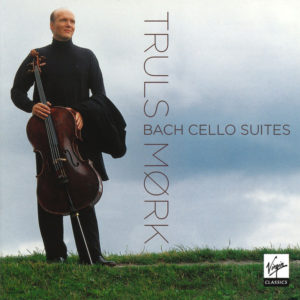
Truls Mørk Bach Cello Suites. Virgin Classics 724354565021. Released 2005.
Recorded July 2005. Riks Church Oslo.
Instrument. Domenico Montagnana.
The Cellist.
Truls Mørk is part of a small but growing number of Scandinavian cellists who have emerged over the last 50 years.
The Recording.
Cutting to the chase, I have to say this is a definite choice for the short list of essential recordings of the Suites. To start, I found the performance a little underwhelming. However, it soon impresses with very considered and refined playing. Most of all it possesses a great sense of smoothness and flow, like a watercolour painting.
Above all, there is rhythm and pace in faster movements but predominantly the style is quite romantic and lyrical (played in the style of a singer). As I listened through the first three suites and then into the fourth, it became very apparent that Mørk has a superb technique. There is precision and attention to detail. This gets more impressive the more demanding the music.
Sometimes as one listens to the Suites from beginning to end, one can get a sense that the performer is getting less and less secure and only just keeping things together. With this performance I felt that he was actually growing in stature and enjoying the challenge.
On top of the superb technique and sense of rhythm is a sense of sincere musicality which draws the listener in and compels continued listening.
There is romanticism but it is not overblown. Although musicality is always difficult to quantify, I think a lot of it in this case comes down to the delicate way each note and phrase is carefully ended.
Mørk’s legato playing is incredible giving Fournier a run for his money I would venture to suggest.
Highlights.
Highlights for me were the Prelude of the fourth Suite where the recording’s Church ambience combined with perfect intonation provided a great sense of polyphony or sense of multiple voices.
Unlike many performers, Mørk does not emphasise any particular part of a bar but gives the music a sense of motion with the feeling of one beat per bar which is very attractive. Similarly, the fifth Prelude in the fugue section has a sense of one beat to the bar with no sense of the 3/8 time signature moving into a waltz.
The fifth Sarabande is played with great precision but has a gentle and delicate touch. Again the ending of each phrase has one on tenterhooks, savouring the last sound.
Conclusion.
Background reading revealed a friendship with the singer, Dietrich Fischer-Dieskau. This would logically complement his style of playing. The following link is to a transcript of an interview with Mørk from which one can gain further insight into the mind set behind his performances.
http://www.cello.org/Newsletter/Articles/mork.htm
In case you need clarification I strongly recommend this recording from perhaps an unexpected source!
Charles.